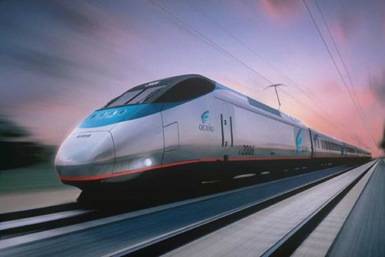 It has been just over a month since Illinois submitted its official request for more than $4 billion in High Speed Rail funding and the continued meetings between state and local leaders in Springfield have yet to yield an agreement of any sort.
It has been just over a month since Illinois submitted its official request for more than $4 billion in High Speed Rail funding and the continued meetings between state and local leaders in Springfield have yet to yield an agreement of any sort.
Sangamon County Board Chairman Andy Van Meter, Springfield Mayor Tim Davlin, IDOT Secretary Gary Hannig and staff members representing Senator Dick Durbin are currently meeting on a weekly basis to negotiate the location of a proposed high speed line. According to Van Meter, “the meetings have been positive, [but there are] some pretty substantive issues that are hanging us up.”
However, these issues are small peanuts when we look at the bigger picture of High Speed Rail. The opposition spans far beyond the state capitol. In the second part of this series we take a look at whom and what are holding back High Speed Rail and just why these forces might have good reason for opposition.
Did you miss Part One? Read it here.
The Midwest is hoping to be one of the largest recipients of High Speed Rail funds. And according to Wisconsin Department of Transportation representative Mark Wolfgram, “We are looking for the president to announce the ARRA grants in his State of the Union speech early in 2010.”
This means that by this time next year, construction on new and upgrades to existing rail lines could be underway. Standing in the way of this becoming a reality, remain obstacles of both public and political opposition. Local governments (such as Springfield), lobbyist groups and even the general public all have fair arguments against High Speed Rail.
STATE VS. SPRINGFIELD
The debate in Springfield is not necessarily over the proposal of High Speed Rail itself, but rather the use of the Third Street corridor the state plans to run a line through the city. The Greater Springfield Chamber of Commerce, along with local officials from Springfield and Sangamon County, are worried that a new rail line along Third Street (where Amtrak and Union Pacific already operate) would not only more than double passenger train traffic but nearly triple freight traffic, causing increased congestion in the redeveloped downtown and hurt local business.
The Chamber and local government are urging the state to instead route the line along 10th Street where Norfolk Southern owns the right of way. While talks continue and both sides remain positive, little progress has been made. Should the state go ahead with its plan, Springfield has vowed to sue.
The negotiations in the capital city have caught the eye of House Speaker, Michael Madigan. Madigan is sponsoring a bill that would bar the state from spending any money, federal or otherwise, on any rail line along Third Street. Along with the threat of being sued, this bill could potentially create a much larger roadblock for a proposed line between Chicago and St. Louis.
THE KEVIN COSTNER IDEOLOGY
The Cato Institute, a Washington D.C. based right-wing think tank, is one of many groups in strong opposition of High Speed Rail. Cato’s Randall O’Toole regards High Speed Rail as a “Field of Dreams” with a “build it and they will come” philosophy fueling the proposal. O’Toole points to data from Harvard economist Edward Glaeser which concludes that the costs of High Speed Rail would outweigh its benefits nearly twice over.
Cato has also scrutinized the Obama Administration for its desire to compete on the international field with Europe and Asia. Cato argues that the rail lines of European nations are federally subsidized and turn over no profit in most cases. They also make the case that high speed lines would not work in the United States because population densities are nowhere near those of European cities and Japan.
While probably the largest of its kind, Cato is not the only foundation informing the masses of the downfalls and shortcomings in the promise of High Speed Rail. Millions of dollars are being spent nationwide to prevent a single high speed train from ever seeing the light of day in the U.S.
CHICAGO TO ST. LOUIS IN HOW LONG?
Should High Speed Rail overcome its political foes, it will eventually have to deal with the public. The reality of 220 MPH trains in the U.S. is very questionable. Even the 110 MPH lines would not be up and running until 2015 at the very earliest. Initial research estimates the 220 MPH lines would not be accessible until 2030, at a cost in the hundred of billions of dollars.
Essentially this means that a trip between Chicago and St. Louis on a 110 MPH line would only cut down about an hour of travel time from the current 79 MPH line. Many passengers would not be willing to pay the added costs for “high speed rail” resulting in reduced ridership and perhaps even making rail travel obsolete.
At the end of the day would the public be willing to watch over $4 billion in federal dollars go towards a program that could prove useless? Stay tuned for the third and final part in this series.








